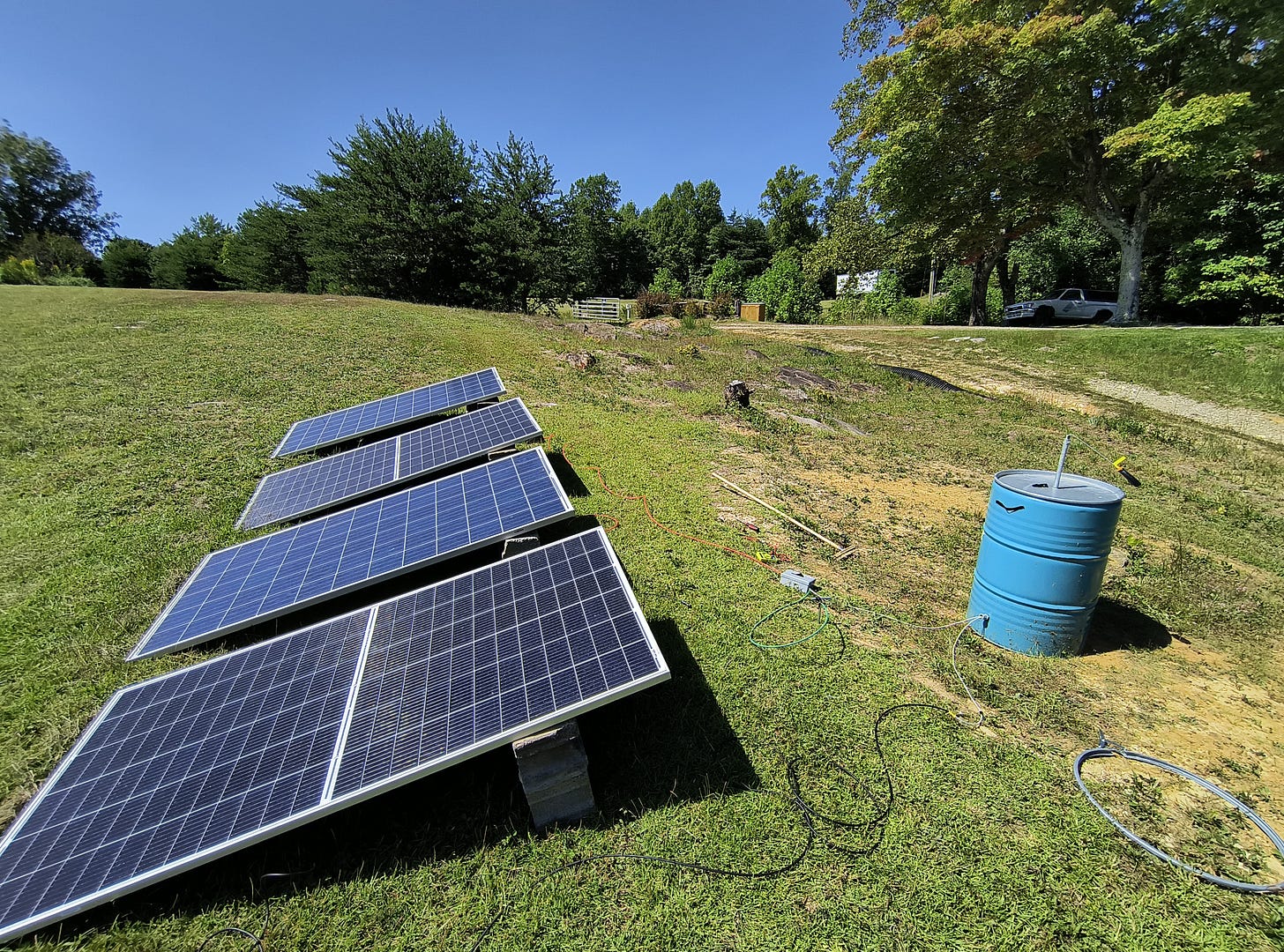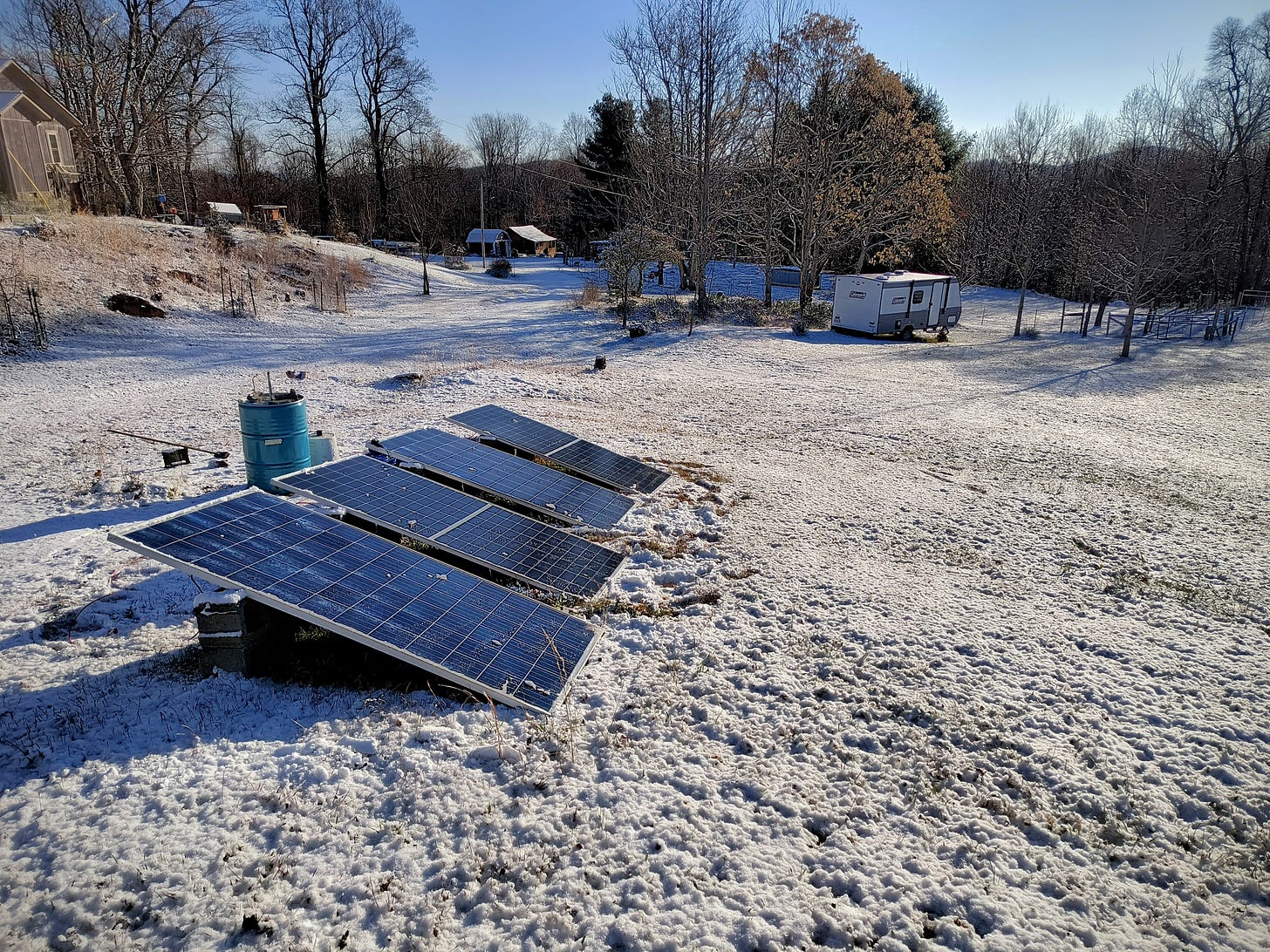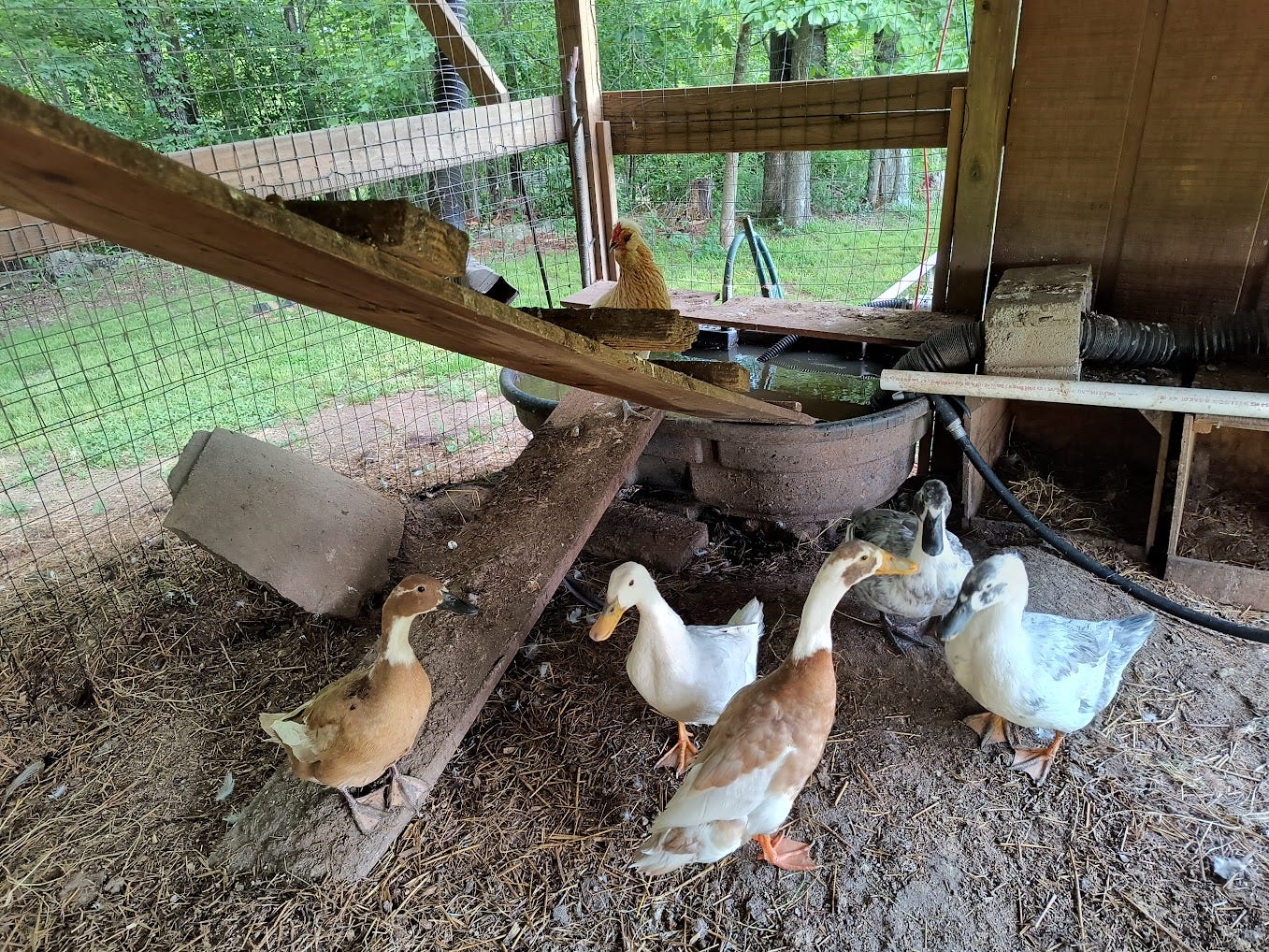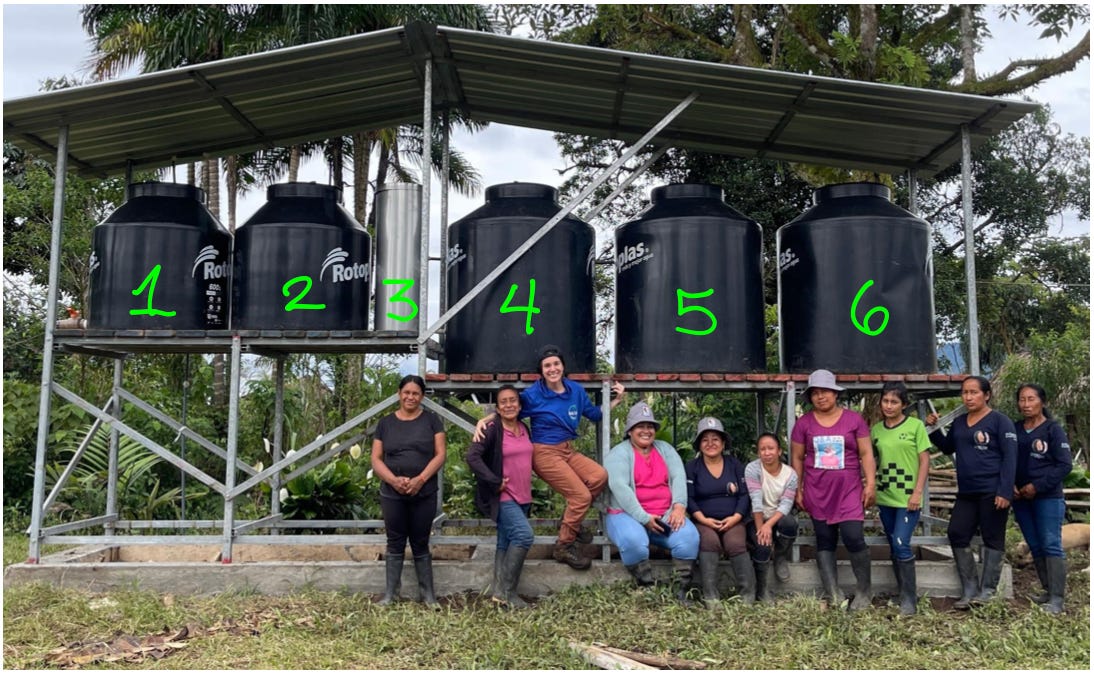Apologies for the recent lack of activity on this site/newsletter. It’s been a busy season and we have a bunch of projects all going on simultaneously. Everything is “in-progress,” and it can be hard to find pause-points to pull back and put together overviews and deep-dives where appropriate.
For now here are snapshots of a few things we’re working on, as previews for coming articles.
Solar biochar/bone char
A while back I wrote about new R&D using solar (PV) power to make biochar and bone char:
Despite proximity to the winter solstice, on clear sunny days the system was able to attain and hold excellent thermal conditions for making bone char sorbent. For example:
kLux is a measure of sunlight intensity falling on the PV panels. The bottom plot shows temperature within the pyrolysis reactor. A control system (thermostat) was used to keep the temperature just below 500 C. On the day these data were collected the average ambient temperature was 33 F (0.6 C) with a high of 49 F (9.4 C) and a low of 17 F (-8.3 C).
Even on a December day at temperate latitude the system was able to maintain 500 C for about 4 hours. These are excellent pyrolysis conditions for making bone char sorbent for fluoride removal.
Preliminary data indicate our solar bone char substantially outperforms two commercially available bone chars for fluoride removal from groundwater:
In summary…
Process uses sunlight falling on PV panels to provide the energy to drive pyrolysis - and thus does not require wood or other biomass fuel, propane, etc.
High precision temperature control is achieved. A suitably sized PV array can provide ample power even when skies are partly cloudy or overcast.
Labor inputs are simplified and reduced. Feedstock is added to the reactor, the thermostat is set, and the reactor is switched on. The reactor can be shut off at any time, or allowed to cool naturally after sunset.
UPDATES
The bone char results were so promising we built a second unit for Caminos de Agua to use in their in-house bone char production.
I recently completed and shipped out a third solar biochar oven for a client in Austin, Texas who operates a food waste and organic matter composting and up-cycling business.
With the second and third iterations we have incorporated a variety of design improvements based on experience operating the ovens.
Solar-powered biochar oven and control system. With this version the temperature controller is powered by a solar-PV rechargeable battery pack, so the system functions 100% off-grid.
In the previous article I mentioned some ongoing R&D items, including:
Scale up for larger batch sizes (prototype batch reactor size is 20 gallons (75 liters).
Possible to make pseudo-activated biochar for adsorption of organic chemical contaminants akin to high temperature gasifier biochar?
Simple emission controls for offgassing pyrolysis vapors.
Production of commercial units for sale to biochar enthusiasts? Inquire if interested…
I’m currently working on the emission control system - essentially an afterburner for combusting pyrolysis gases as they exit the chimney.
I also got some very promising preliminary results using feedstock pretreatments to achieve pseudo-activation conditions at modest pyrolysis temperatures:
Organics adsorption assay on chars made from hardwood sawdust pretreated with high pH solutions of wood ash, calcium hydroxide, or sodium hydroxide. Also, biochar made from hardwood sawdust pretreated with distilled/de-ionized (DI) water (control), and DI-water-pretreated biochar treated with sodium hydroxide and re-pyrolyzed. For comparison, the high temperature semi-aerobic gasification biochar (“GSB,” or “Gold Standard Biochar” as it is the most-studied bochar in the world for organics adsorption). Here, all feedstocks were pyrolyzed at 600 C.
In short, the data above indicate that pretreating feedstock with sodium hydroxide solution prior to pyrolysis at 600 C can generate an adsorbent with similar organics uptake as a semi-aerobic gasification biohcar produced at much higher temperature (900-1,000 C). Other base pretreatments of feedstock, e.g. calcium hydroxide, ash water, don’t work as well for facilitating pseudo-activation conditions during pyrolysis of hardwood sawdust, apparently. (For more info about base and metal cation pretreatments, see here, and our publications page.)
This is potentially a big breakthrough since the temperatures needed for thermal-air activation of biochar adsobents (>850 C) is really hard on equipment. For a simple, inexpensive drum oven thermal stresses wearing out equipment can be an acceptable cost, and in really low resource situations the high temperature gasifier method might be all that is feasible.
But if biochar adsorbent effective for uptake of organic chemical contaminants can be generated at 600 C, or even below 600 C, that is a really important result because oven components can withstand those comparatively modest temperatures much better than 900 or 1,000 C.
The results above also indicate biochars with moderate or poor organics adsorption (e.g. the “DI water” pretreated biochar above) can be upgraded by base treatment and re-pryolysis.
I demonstrated this dramatically as shown by the data below using a biochar made from recycled tires. The raw tire biochar had poor organics adsorption performance, and even leached color and odor into the water. But tire biochar treated with base and repyrolyzed (at 600 C) had some of the most impressive organics adsorption performance.
Tire biochar upgraded to better adsorption performance by treatment with base and repyrolyzed at 600 C.
SUMMARY
In summary, the solar/electric biochar oven is versatile in the range of materials and material properties it can produce. It can be run fully off-grid, or on-grid (Caminos intends to run theirs on-grid out of fear of theft of PV panels in their area).
N.B.: I have glossed over a bunch of details here intentionally. For a while I thought I might patent this design and classify it under intellectual property restrictions. I’ve thought about it and talked it through with some “experts,” and decided to release the design open-access under Creative Commons license.
I omitted details here because all that will be supplied in a forthcoming post illustrating the design, fabrication, and use of the solar biochar oven.
Fun with constructed wetlands
We often get asked:
“Will your (e.g., blue barrel) system work for gray water or wastewater/septage, or water sources impacted by gray water or wastewater?”
The answer to this question is:
“Probably not without pretreatment.”
The reason is that gray water, wastewater, sewage, and water sources impacted by these, contain a lot of solids, dissolved organic matter, and harmful pathogens such as E. coli.
If you pipe that water right into a gravel filter→sand filter→biochar adsorber treatment system, the whole system goes anaerobic (stinky and gross) and nasty microbes take over. It quickly becomes a messy failure.
Therefore alternative source water(s) should be sought. However, if your only choice is a water body impacted by sewage, gray water, livestock manure, etc., one option could be to use a constructed wetland to provide natural biological pretreatment to improve water quality to the point that it could be further treated in the gravel→sand→biochar system and then safely consumed.
Constructed wetlands use plants and aquatic organisms along with other natural physical and chemical processes such as hydrolysis, photolysis, and solar-UV inactivation to improve water quality.
At some point I will do a deep-dive summary of constructed wetlands for water quality improvement here. But for now, since I am always tinkering I’ll provide a thumbnail sketch of a mini constructed wetland approach I have been developing for treatment of duck wastewater.
Anybody who has raised ducks knows that they are messy. They poop everywhere! A lot! Especially in the water.
I’m actually grateful that they poop so much in their water tub, since I use the poopy duckwater to “fertigate” fruit trees and berry bushes and grape vines. The ducks are for fertilizer - the eggs are a bonus.
But I am always trying to find clever ways to get more out of our agroecosystems, and I can’t resist a try-it-and-see water project.
Here I have rigged up a 12 volt DC wastewater macerator pump (commonly used in RVs and marine applications) to suck up the poopy duckwater and pump it into a mini constructed wetland.
The pump is powered by the two PV panels shown in the photo above, and is controlled by a programmable DC controller unit wired up through the box on the wall.
I put a couple water hyacinth and water lettuce plants in the wetland tub a few weeks ago and they have started to multiply bigtime! (Note that these are invasive plants and so shouldn’t be used if there is a risk to a nearby water body).
The water hyacinth and water lettuce take up nutrients from the poopy duckwater. This partially cleans it before it flows by gravity back into the ducks’ water tub. Make-up water is supplied by gravity flow from rainwater tanks.
Ducks love to eat water hyacinth and water lettuce so I am using their wastewater nutrients to grow a portion of their food, thus cutting our feed costs.
I’m still working kinks out of the system to get it operating seamlessly. Once things are optimized and in steady-state I will do a water quality study to quantify how much actual improvement is happening.
Once I’m happy with everything I will do a detailed how-to write up and post it here in case people want to replicate or adapt the system.
It’s possible something like this could be used to pretreat poor quality source waters to get enough improvement to put through a gravel→sand→biochar system for producing potable water.
New installations and retrofits in Ecuador
The Ecuador team has been busy installing new water treatment systems. Here are a few photos from a recent (May 2025) installation in a Cofan (indigenous group) community:
The water source is the local Aguarico river.
This project is being carried out by the local women’s association, with funding from The Nature Conservancy and technical support from the Aqueous Solutions/Amisacho team based in Lago Agrio, northeastern Ecuador.
The treament system provides water to a central kitchen and bathhouse that serves the local Cofan community as well as an ecotourism guesthouse.
Tanks 1, 2, and 3 are gravel roughing filter, biological slow sand filter, and carbon adsorber, respectively.
Tanks 4,5 and 6 store treated water. Tank 4 stores water that has passed through all three filters. This water is used for direct consumption: drinking, cooking, washing vegetables, etc.
Tanks 5 and 6 store water that has passed through the gravel and sand filters but bypassed the carbon adsorber. This water is used in showers, baths, handwashing sinks, and other domestic uses.
The Ecuador team has made very good use of this “tiered treatment” approach in our projects there - i.e., treating water to an appropriate level for its intended use. Whether locally made biochar or imported activated carbon is used in the carbon filter-adsorber, this unit process is often the most costly on a per-liter basis. The carbon adsorber can be made much smaller - and therefore less costly and labor-intensive - if it’s just used for directly consumed water.
Or, put another way, treated water of adequate quality for non-consumptive domestic uses can be provided at modest additional cost to providing drinking water.
LEFT: constructing the concrete foundation for the treatment system. RIGHT: water tanks and other project materials were transported to the village by canoe.
LEFT: Washing sink installed in central kitchen with taps (water not treated by carbon adsorption) and gray water drain. RIGHT: Kitchen taps for water treated by carbon adsorption for drinking and cooking.
LEFT: Gray water from kitchen piped away for “fertigation” of fruit trees. RIGHT: Drinking water tap installed in common area.
LEFT: Plumbing connected for showers and handwashing sinks. RIGHT: Clothes washing station.
May 24, 2025: Carlos, the local technician elected by the women’ association, explains the function and maintenance of the treatment system.
RETROFITS OF DISUSED INFRASTRUCTURE
Over the years, many thousands of water systems have been installed in communities throughout the Ecuadorian Amazon. Unfortunately, many of these systems are poorly designed. They often fail, and are abandoned by locals.
A well built but poorly designed water system, sitting unused by the local community.
A new direction our work is taking us is the redesign and retrofit of disused and abandoned water infrastructure. What’s great about this is that a lot of the expensive stuff is already done - the nice towers shown in the photo above for example. The water tanks, piping, etc. are usually fine, just not configured properly, or not configured optimally.
So for a fraction of the time, labor, and cost of building a new system from scratch we can reconfigure existing infrastructure to make it work well, and add features - such as biochar adsorption for control of chemical contaminants - that existing systems lack.
Thank you again for your interest in our work. Detailed write-ups on these and other topics coming soon.
Ecuador


















